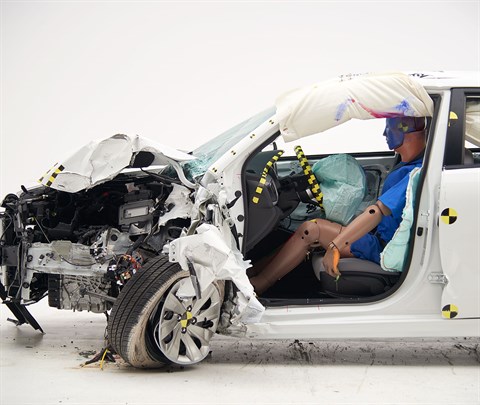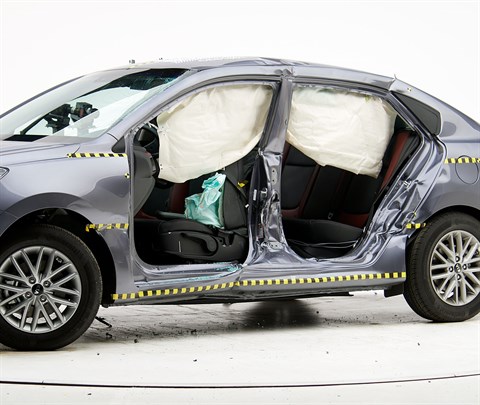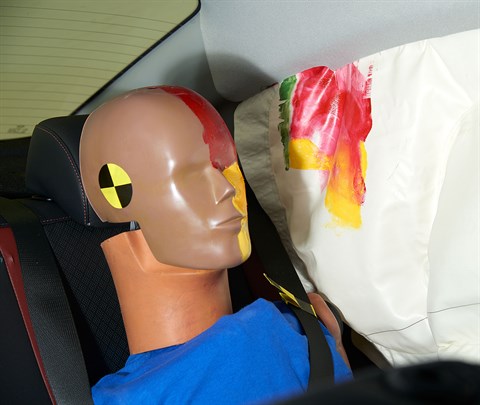Small overlap front: driver-side
Rating applies to 2018-23 models
Tested vehicle: 2018 Kia Rio LX 4-door
The Kia Rio and Hyundai Accent were redesigned for the 2018 model year and are now built on the same platform. The driver-side small overlap frontal ratings apply to both the sedan and hatchback versions of the Rio as well as to the Accent, available only as a sedan beginning with 2018 models.
| Evaluation criteria | Rating |
|---|---|
| Structure and safety cage | |
| Driver injury measures | |
| Head/neck | |
| Chest | |
| Hip/thigh | |
| Lower leg/foot | |
| Driver restraints and dummy kinematics | |

Action shot taken during the driver-side small overlap frontal crash test.

The dummy's position in relation to the door frame, steering wheel, and instrument panel after the crash test indicates that the driver's survival space was maintained very well.

The frontal and side curtain airbags worked well together to keep the head from coming close to any stiff structure or outside objects that could cause injury.

Forces on the left lower leg and foot were high enough to indicate a moderate risk of injuries.
Small overlap front: passenger-side
Rating applies to 2018-23 models
Tested vehicle: 2018 Kia Rio S 4-door
The Kia Rio and Hyundai Accent were redesigned for the 2018 model year and are now built on the same platform. Passenger-side small overlap frontal ratings are assigned by the Institute based on a test conducted by Hyundai/Kia. Ratings apply to both the sedan and hatchback versions of the Rio as well as to the Accent, available only as a sedan beginning with 2018 models.
| Evaluation criteria | Rating |
|---|---|
| Overall evaluation | |
| Structure and safety cage | |
| Passenger injury measures | |
| Head/neck | |
| Chest | |
| Hip/thigh | |
| Lower leg/foot | |
| Passenger restraints and dummy kinematics The dummy’s head barely contacted the frontal airbag before sliding off the right side, leaving the head vulnerable to contact with forward structure. The side curtain airbag deployed and has sufficient forward coverage to protect the head from contact with side structure and outside objects. | |
| Driver injury measures | |
| Head/neck | |
| Chest | |
| Hip/thigh | |
| Lower leg/foot | |
| Driver restraints and dummy kinematics | |
Moderate overlap front: original test
Rating applies to 2018-23 models
Tested vehicle: 2018 Kia Rio LX 4-door (hatchback)
The Kia Rio and Hyundai Accent were redesigned for the 2018 model year and are now built on the same platform. Moderate overlap frontal ratings are assigned by the Institute based on a test conducted by Hyundai/Kia. Ratings apply to both the sedan and hatchback versions of the Rio as well as to the Accent, available only as a sedan beginning with 2018 models.
| Evaluation criteria | Rating |
|---|---|
| Overall evaluation | |
| Structure and safety cage | |
| Driver injury measures | |
| Head/neck | |
| Chest | |
| Leg/foot, left | |
| Leg/foot, right | |
| Driver restraints and dummy kinematics | |
Side: original test
Rating applies to 2018-23 models
Tested vehicle: 2018 Kia Rio EX 4-door
The Kia Rio and Hyundai Accent were redesigned for the 2018 model year and are now built on the same platform. The side ratings apply to both the sedan and hatchback versions of the Rio as well as to the Accent, available only as a sedan beginning with 2018 models.
| Evaluation criteria | Rating |
|---|---|
| Overall evaluation | |
| Structure and safety cage | |
| Driver injury measures | |
| Head/neck | |
| Torso | |
| Pelvis/leg | |
| Driver head protection | |
| Rear passenger injury measures | |
| Head/neck | |
| Torso | |
| Pelvis/leg | |
| Rear passenger head protection | |

View of the vehicle and barrier just after the crash test.

View of the vehicle after the crash with doors removed, showing the side airbags and damage to the occupant compartment.

Smeared greasepaint shows where the driver dummy's head was protected from being hit by hard structures by the side curtain airbag.

Smeared greasepaint shows where the rear passenger dummy’s head was protected by the side airbag.
Roof strength
Rating applies to 2018-23 models
Tested vehicle: 2018 Kia Rio S 4-door
Rating applies to the Rio 4-door sedan (tested), Accent 4-door sedan, and the structurally similar Rio 4-door hatchback (5-door).
| Overall evaluation | |
|---|---|
| Curb weight | 2,565 lbs |
| Peak force | 14,544 lbs |
| Strength-to-weight ratio | 5.67 |
Head restraints & seats
Seat type: Manual cloth seat
| Overall evaluation | |
|---|---|
| Dynamic rating | |
| Seat/head restraint geometry |
About the head restraint & seat test
Currently, IIHS tests apply only to front seats.